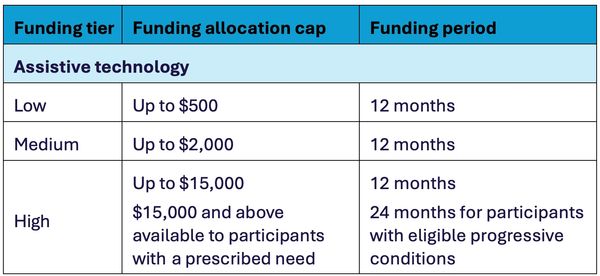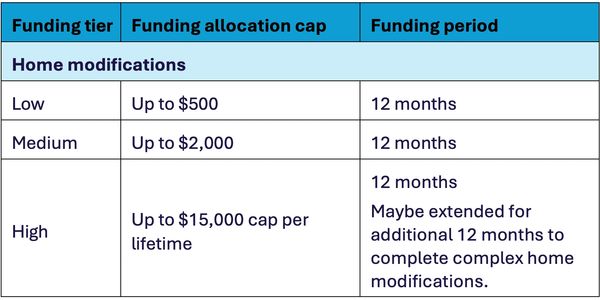AT-HM Scheme
The Department of Health, Disability and Aging has released the Assistive Technology and Home Modifications (AT-HM) Guidelines. This document outlines how aged care providers should provide AT-HM under the Support at Home program and engage allied health providers like us to prescribe, justify, and document recommended AT and HM.
The most recent release can be found through this link.

What is Assistive Technology?
Assistive Technology (AT) refers to equipment, devices, or products that help older Australians live safely and independently at home. AT includes items such as mobility aids, bathroom safety equipment, personal care supports, and daily living aids that reduce risks, improve function, and support participation in everyday activities.
The goal of AT is to support function, promote independence, reduce carer burden, and enable participants to continue living safely and comfortably at home.
AT is funded through the AT‑HM Scheme and has 3 Funding Tiers: Low, Medium and High

What is Home Modification?
Home Modifications (HM) refer to physical changes made to a participant’s home to improve safety, accessibility, and independence. Under the Support at Home program, these modifications are also funded through the AT-HM Scheme and must be clinically justified by an Occupational Therapist. Examples include installing grab rails, ramps, widening doorways, modifying bathrooms, or adjusting flooring to reduce trip hazards.
The goal of home modifications is to reduce risks, support mobility and personal care, and enable participants to remain living safely in their own homes for longer.
HM is funded through the AT-HM Scheme and has 3 Funding Tiers: Low, Medium and High

Assistance Dog
Under the Support at Home program, assistance dogs may be funded where clinically justified and aligned with the participant’s assessed care needs. Funding for assistance dogs under the Support at Home program is subject to assessment, clinical recommendation, and approval by the Department based on the participant’s goals and individual circumstances.

What is fundable?
- Managing body functions, such as pill (dosette) boxes, products to enhance cognitive function, pressure relief cushions, and upper/lower limb orthoses
- Self-care products, such as toileting and showering equipment, small aids for dressing clothing and shoes, washable absorbent products, urinals and bedpans
- Mobility equipment, such as walking sticks, crutches, walking frames, seat walkers, manual or powered wheelchairs and their accessories
- Domestic life products, such as adaptive cutleries, chairs and stools
- Communication and information management products, such as visual and tactile devices, communication software and note taking devices
- Home Modifications (HM): Ranging from grab rails, handrails and ramps to full bathroom modification, they must be clinically justified and aim to improve function, safety or independence.

How to access the AT-HM Scheme
To receive funding under the AT-HM scheme, an older person must first undergo an aged care needs assessment, during which their needs for assistive technology (AT) and/or home modifications (HM) are identified and recorded in their support plan. Following this, they will receive a Notice of Decision letter confirming their eligibility and be placed into a priority system. Based on their assessed needs, they may then be assigned to one or more funding tiers which determine the type and level of AT-HM support they can access under the scheme.

AT-HM scheme Data Collection
The AT-HM scheme data collection process is a temporary pathway for providers to support their transitioned Home Care Package (HCP) care recipients. The AT-HM scheme data collection will run from October 2025 to February 2026. The providers will need to nominate and register a data collection coordinator to manage the AT-HM data collection process within their organisations. During the transition to Support at Home, as an existing HCP care recipient, the participant will be automatically approved for the AT-HM scheme (with $0 allocated to both AT and HM Scheme).

Support Plan Review (SPR)
A Support Plan Review (SPR) can be requested by an older person or their provider when changes to their AT-HM funding tier are needed. For example, the participant needs to move to a different tier, add AT or HM support to an existing classification, or enable repairs for previously funded items. SPRs can be initiated via My Aged Care or the Services Australia Aged Care Specialist Officer, and providers can submit requests through the My Aged Care portal. The review may result in no change, a tier update, or a full reassessment.

Sourcing Assistive Technology (AT)
Providers can assist the participants to source AT-HM through the:
- purchase of AT
- private rental of AT
- National Assistive Technology Loans Scheme (when available)
- older people who have been approved for AT-HM scheme funding can access low cost / low risk items from the AT-HM list and have this reimbursed by their provider

Funding period
AT-HM funding is granted in fixed 12-month periods and is based on an older person’s assessed need for AT-HM, with separate funding tiers allocated for each. These tiers provide a set dollar range to spend on approved equipment, services, and support. Funding does not accrue and must be spent (not just committed) within the funding period (typically 12 months), after which providers have an additional 60 days to finalise claims. No new entry notification is needed if one has already been submitted for the same client and provider. Funding begins once the provider’s start notification is accepted in the Aged Care Provider portal. Eligible uses include equipment purchases, repairs, prescriptions by qualified health professionals, wraparound services (e.g., delivery, training, follow-up), and capped administrative or coordination costs.

Progressive conditions funding period
Older people diagnosed with specific complex and progressive conditions (such as Parkinson’s disease, motor neurone disease, or stroke) may receive a longer AT-HM funding period due to their evolving needs. These individuals may be granted a 24-month AT and/or HM High funding tier. This extended funding can be used for AT, prescriptions, wraparound services (e.g., setup, training), and administration costs.

Prescription services by health professionals
A prescription is a written recommendation from a qualified health professional (e.g. Occupational Therapist, Physiotherapist, Speech Pathologist) working within their scope of practice, recommending AT or HM to meet an older person’s age-related functional decline or disability. Prescriptions are typically based on a home or functional assessment, though in some cases they may be completed via telehealth when appropriate.

Wraparound services by health professionals
Wraparound services are additional supports funded through the AT-HM scheme to ensure that AT and HM are safely and effectively implemented in an older person’s home. These services may include:
- Delivery of equipment or products
- Set-up of AT
- Training and education on the safe use of AT or HM
- Follow-up to assess whether the AT or HM is meeting the person’s needs
- Repairs and maintenance of eligible AT items
- Administrative or coordination costs involved in arranging services
- Retrieval of loaned or rented items when they’re no longer needed

Quick Checklist by Providers
When considering if AT or HM may be fundable under the AT-HM scheme, check:
- Has it been prescribed and justified by a qualified professional, such as an Occupational Therapist. Speech Pathologist or Physiotherapist?
- Does it address a functional limitation or safety risk?
- Is it necessary and reasonable for daily living (not comfort or preference)?
- Is there supporting evidence such as a trial, risk assessment, or quote?
- Has the client agreed to the proposed AT-HM solution?
If the answer is “NO” to any of these, it is unlikely to be fundable under Support at Home.

How Super Rehab Aligns with the Guidelines
- Structured fee schedule that clearly separates face-to-face (“Direct”) and non-face-to-face (“Indirect”) activities, including prescription and wraparound services under the AT-HM scheme.
- Robust clinical governance to meet the expectations outlined in the AT-HM Scheme Guidelines, safeguarding the safety and wellbeing of Support at Home participants while upholding the trust and accountability expected by referrers.
- Efficient work procedures aligned with new compliance requirements, including standardised report templates, quote checklists, and risk assessment tools.

Referral & Next Step
If you are a provider, care partner or family member supporting a participant under Support at Home (SAH) or (Restorative Care Pathway) RCP, we invite you to connect with us:
- Complete our online Referral Form
- Or call our referral team on (02) 8970 4632
- Once referred, we’ll schedule an initial assessment and align our plan with your participant’s support goals
Super Rehab acknowledges the Traditional Owners of the land where we work and live, and pay our respects to Elders past, present and emerging. We celebrate the stories, culture and traditions of Aboriginal and Torres Strait Islander Elders of all communities who also work and live on this land.
Copyright © 2020 Super Rehab Pty Ltd
